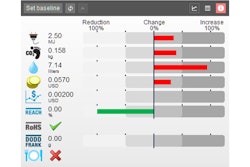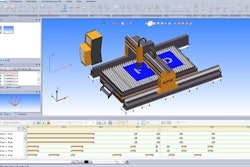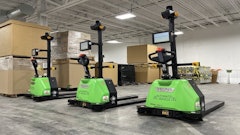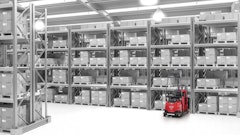As automobile manufacturers continue to expand their production and supply chain networks worldwide, an increasing number of parts are transported by ship to the production site in mixed-part containers. During the long journey from continent to continent, the production program changes frequently, so the demand for parts is different from the time the containers were loaded to the time they arrive at their destination. Upon arrival, the question of “Which container should to be transferred to stock first at the warehouse located upstream to the production site?” may pop up. The answer would be a plan that selects the order that is ideal and most cost effective.
Each day, in a global company, a responsible material dispatcher comes to the office, starts up his personal computer (PC) and checks the status of materials in the system. With a smile, he leans back with satisfaction. This is because the container yard management software that he uses to control the stock levels in the container yard and warehouse shows him all green lights. The system did its job by comparing the current inventory in yard and on hand in the warehouse to the current production schedule, and creating an optimal unload plan. The containers that started their journey first by ship, then train, then truck cleared customs and reached their destination in the container yard. The arrival was in due time and the parts were transferred to stock according to the current production schedule in the most optimal fashion, while considering cost, inventory, production needs and other critical factors.
This scenario corresponds to the wishful thinking of many car manufacturers, who are expanding production sites worldwide, and who are looking to improve efficiency, transparency and security in their parts supply. In recent years, GM, Ford, VW and others built assembly plants in emerging markets like Brazil, Mexico, China and India. They want to serve these growth markets quickly, with flexibility and with local proximity. For example, VW being present in the automotive market of the U.S. was so important that the company built a new plant in Tennessee. However, many vehicle components are still coming from Germany, as the supplier network was not fully developed yet.
In addition, original equipment manufacturers (OEMs) are sourcing many supply parts in lower cost regions, creating long lead-time supply networks. Therefore, a lower cost transportation time includes boat or rail networks that have lead times ranging from six to 12 weeks respective of the location. During this time, the production programs that were the drivers for the original order and container shipments change due to market fluctuations and providing flexible production worldwide. This means that the part mix in the original containers does not correspond directly to the new demand situation and new production requirements. In order to still execute the new production plan for each vehicle with minimal disruption and part expediting, every container available in the yard must be analyzed, and the ones with the appropriate content must be prioritized and then unloaded to transfer required parts to the warehouse.
So far, most automobile manufacturers record the parts on manual worksheets or overstock the warehouse with unrequired parts. The material manager would then check part inventory or their list to see if the parts required for production are available. If there is insufficient inventory, the material handler would then look for a container that includes the required parts. The material handler would then opt for the container that is the oldest and includes the required part, opt for a container that has multiple requirements, or opt for the first one on the list that contains the needed parts regardless of age or other contents. In most cases, this is a time-consuming, manual process that can lead to errors. In such a process, there is no vision as to which part is about to run out, nor is there any related optimization logic used to adjust the container delivery schedule when requirements change.
The decision as to which container to unload only considers the first container that arrived or whether the container includes a priority part based on some known shortage. In other cases, production can fall behind or other changes occur, which creates a container yard overflow or abundance of inventory in the warehouse. If this condition occurs, containers are often unloaded to ensure that penalties are not incurred based on custom clearance regulations. These containers may not include parts required for production, and therefore, either penalties are incurred or additional excess inventory is placed in the already jammed warehouse.
Global Supply Chain Networks Need Flexibility
Global supply chains create major challenges for automakers due to longer lead times and the need to maintain flexibility to the sales markets. The uncertainty, which results from changes in demand, needs to be reduced to an economically acceptable level. Initial production plans and supply orders are based on forecasts using techniques that model expected buyer behaviors. This could lead to a situation in which at 10+ weeks before production, the supply order time for a long-lead part, a quantity of 1,000 navigation systems are ordered and shipped. However, when the final production plan is fixed, the need for navigation units is reduced to only 500 units. In this case, the actual market requirement was much lower than the original request. In the shipment containers, the navigation unit parts are combined with many other parts to optimize the packing space in the container.
Although the navigation part is a non-critical item due to changes in demand, other parts in containers with the navigation units are required to satisfy the new production plan. Since the navigation units are in multiple containers, it is necessary to determine which containers should be unloaded first from the yard to optimally satisfy the overall production supply needs. Prioritizing the more critical containers, based on content to reduce the threat of supply shortages, is key. This prioritization helps with the flow within the warehouse by not creating an overstock situation and burdening the warehouse with parts that are not required.
Even if a vehicle model was being produced for some time and the containers are loaded according to customer orders, the production schedule changes during the voyage. This may be due to both external and internal reasons:
- Short-term changes in customer needs. Depending on the degree of change, customers are allowed to request specific features on vehicles at the time of order, which changes the vehicle configuration for manufacturers with little advanced notice relative to time of production. When customers order specific features that require manufacturing change, for example, ordering a vehicle with a sunroof that was originally planned to stock without a sunroof, the production and parts delivery must adapt accordingly.
- Production-related reasons. Due to problems with equipment or other interruptions, specific vehicles or configurations may not be produced at a given time. For example, a casting die breaks that produces a specific version of an engine block, causing all vehicle production with that feature to be delayed until the equipment is repaired and that specific block is readily available again. This creates a major bottleneck of that part, and prohibits the completion of a specific engine model or type. In this case, production of all vehicle orders requiring that engine block must be re-planned to a future date or the orders must use a substitute engine configuration that uses a block that is available.
- Supplier-related reasons. Due to seasonality or changes to part production equipment, a supplier is unable to produce a specific part for a period of time, such as a convertible roof assembly. This part becomes a bottleneck, and production of orders with this feature need to be moved to a later production date or to a different configuration. In this case, all convertibles are removed from the existing production plan and replaced by other orders with non-convertible features. Due to such changes, other parts and suppliers are affected, which need to be evaluated.
- Logistics-related reasons. In some cases, suppliers or warehouses may ship the incorrect part variant, or a container is delayed being delivered to the warehouse destination. In this case, there may be a temporary part shortage or bottleneck that is impacting vehicle production. Once caught, the schedule may be switched around within a very short time to optimally produce vehicles with available materials on hand.
To quickly remedy these types of situations, the material dispatcher must determine which parts are the bottlenecks and what specific orders are affected. After identifying a problem and understanding the root cause, immediate steps to procure and deliver the missing or replacement parts must be taken. Such actions may be: special transportation or expediting, enforcement of additional working time, utilization of alternative suppliers, substitution of bottleneck parts with different variants, or numerous other temporary or permanent solution options.
The Right Container for Optimal Parts Demand Coverage
Wishful thinking and reality are sometimes not that far apart. What many logisticians previously only dared to dream is now possible. flexis AG, a specialist in the planning, optimization and control of commodity flows, developed a software solution for container yard optimization. It evaluates the available containers and contents to determine which one best fits the current demand situation. Thus, an optimal sequence for container retrieval is determined.
In managing the daily changes in part demand or part bottlenecks, warehouse handling and delivery should amount to the least possible cost impact. Using a sophisticated system, like flexis Container Management, allows for a complex constraint model with different penalty values that serve as an evaluation and optimization schema, which reflect different situations and variations. In such cases, the penalty value represents the total cost that would be incurred for each situation if certain conditions are not met. During the optimization, the container delivery schedule with the lowest overall cost, hence the least impact, is determined.
Ideally, not only is parts availability for current demand evaluated, but the demand for future days must also be considered to ensure the best coverage with the lowest immediate and short-term impact. In addition to coverage, the solution must ensure that stock levels do not fall below the minimum on-hand inventory requirements for each part, as well as ensure that costly storage capacity is optimally utilized and not consumed by parts that are not immediately needed. It is given that some parts not immediately needed may consume some warehouse space due to the part mix on different containers that must be unloaded. However, by evaluating each container at the content level, this can be minimized. Besides part coverage, other cost factoring restrictions are considered during the process, such as first in first out (FIFO) principles, to incorporate requirements for customer clearance dates, as well as considering the maximum time a part should be in a container as a result of potential part quality concerns.
When calculating the penalty values, ??the software uses an intelligent approach with linear optimization. The optimization is based on the question of what causes the most overall costs when the values ??are above or below a given target. The penalty values ??represent factors such as: inventory costs, capital commitment, handling costs, and possibly scrap costs per container or item number. The highest penalty is assigned to causing delays in production because it leads to instability, and directly generates additional costs due to downtime, customer dissatisfaction, etc. Typically, there is a difference in cost between container storage in the yard and the utilization of warehouse space. Overall, the less floor space required in the warehouse, the lower the total cost of handling goods. The reduction of inventory in the warehouse is possible thanks to the utilization of software, providing enough transparency for the user to ensure that the necessary parts are available when required for production.
A container can hold up to several hundred different part numbers. There are only a few homogeneous containers, as most are loaded with 30 to 50 part variants. For each part, the minimum coverage is defined. Based on the current demand and inventory situation, the software selects the container in which the overall contents fit better to the current production plan. For example, there is demand for 100 units of a particular shock absorber. There are two containers that each include 100 of the required shock absorber. However, included in those two containers are numerous other parts, which may or may not be needed immediately for production. The software analyzes the total contents of each container, identifying first the required 100 shock absorbers, and then determines of the other parts in the container which containers contents are needed by future demand in the production plan earlier. Basically, from all the available containers in the yard with varying content, the containers that best satisfy the overall business objectives and have the lowest cost are selected.
In operational mode, this selection is a cyclical process: At some defined time, the latest production requirements, current inventory in the container yard, and warehouse inventories are imported into the optimization program and aligned. After the alignment, a proposed plan is available for a certain number of containers with the optimal contents to be transferred to the warehouse. As containers arrive with perhaps more suitable parts, compared to those already in the container yard, planning can be initiated again on short notice to reprioritize the unloading schedule. In case of a threat that production may be delayed, inventory falls below minimum coverage, or if a container must be retrieved for which the customs clearance date was exceeded, the software can automatically send alerts by email. Based on their role, multiple associates are informed of the situation. For example, material dispatchers of the automobile manufacturer may be notified of a particular situation.
An optimized process of container retrieval provides transparency and ensures that parts meet demand in the production plant. The software developed by flexis offers a range of criteria in order to ensure minimum inventory, combined with a proactive container retrieval, and avoidance of special costly measures. The solution helps to boost productivity and efficiency in the container yard.
Shay Sidner is the director of operations for flexis North America, a company that focuses on sales and operations planning, as well as advanced planning and scheduling. Sidner has more than 10 years of experience with supply chain optimization in manufacturing industries.














![Pros To Know 2026 [color]](https://img.sdcexec.com/mindful/acbm/workspaces/default/uploads/2025/08/prostoknow-2026-color.mduFvhpgMk.png?ar=16%3A9&auto=format%2Ccompress&bg=fff&fill-color=fff&fit=fill&h=135&q=70&w=240)






